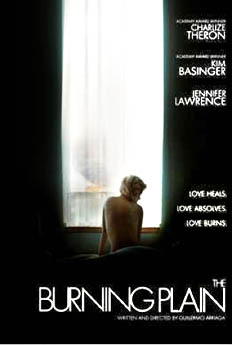 ½
½
Starts May 26
 A singlewide mobile home burns out of control on a desolate, scrub brush and cactus-riddled plain. The Burning Plain’s stark riveting tale of love and betrayal, friendship and forgiveness, anguish, guilt and redemption is permeated with screenwriter Guillermo Arriaga’s distinctive storytelling style (Babel, 21 Grams) that he directs as well.
A singlewide mobile home burns out of control on a desolate, scrub brush and cactus-riddled plain. The Burning Plain’s stark riveting tale of love and betrayal, friendship and forgiveness, anguish, guilt and redemption is permeated with screenwriter Guillermo Arriaga’s distinctive storytelling style (Babel, 21 Grams) that he directs as well.
Sylvia (Charlize Theron) loathes herself: a self-cutter, she unabashedly has sex with whoever is available, although she runs an expensive cliff-side restaurant in Oregon. A sturdy Mexican comes to her rescue, yet declines her sexual offer, then calls her by a name she wants to forget. What secrets does Carlos (José María Yazpik) know? Nick (Joaquim de Almeida) sits on his truck’s hood under the baking sun patiently waiting until Gina (Kim Basinger) pulls up. Their embrace says it all—they are powerless to halt their clandestine liaison.
Meanwhile a group of teenagers investigate the charred remains of the mobile home; this is where Santiago’s (JD Pardo) father died, in bed, with a white woman. Her husband shows up at the funeral, damning his father for making the four children orphans. Santiago curiously gazes at the adolescent daughter as they leave. In this small, racially divided New Mexico town, fates draw him and Mariana (Jennifer Lawrence) together, and they grapple to understand ethnic disparity and their shattered lives. At a Mexican border town, when a call comes in, two guys interrupt a card game to take a job. They haul 8-year-old Maria (Tessa Ia) on board their crop-dusting plane, happily, since she dotes on dad.
Viewed parallel and unencumbered by time dimensions, we piece together the secrets and the veracity that bind these individuals. Strong dramatic acting performances, Robert Elswit’s cinematography, and Omar Rodriguez-Lopez and Hans Zimmer’s original music fit the various climates and terrains like a glove. Special kudos to editor Craig Wood: without his finesse, we may have been too flummoxed to follow the story. Arriaga shows with prismatic clarity how altering perspectives factor in to lives, peoples’ overall values, and in ways each of us can identify with, at some level. It is fitting this 2008 film is making it to a larger audience.
